As an Amazon Associate I earn from qualifying purchases. This website also participates in other affiliate programs and may earn commissions if you shop through the links used on this website.
(This article was originally published on August 11, 2021 and was last updated on September 15, 2022)
Basil plants are a staple in many gardens, herb planters, and kitchens, but as a tender annual, they’re notoriously finicky, too.
Most basil enthusiasts know basil needs to be watered correctly or it will die, but how often should you water basil?
If this your first time trying to grow basil, or you’ve been wondering how often to water basil or how much water does basil need, you’re in the right place.
In this article, I’ll go through how different planting, climate and weather, light and sun, and soil conditions affect how much water basil needs, and how you can adjust your basil watering schedule accordingly.
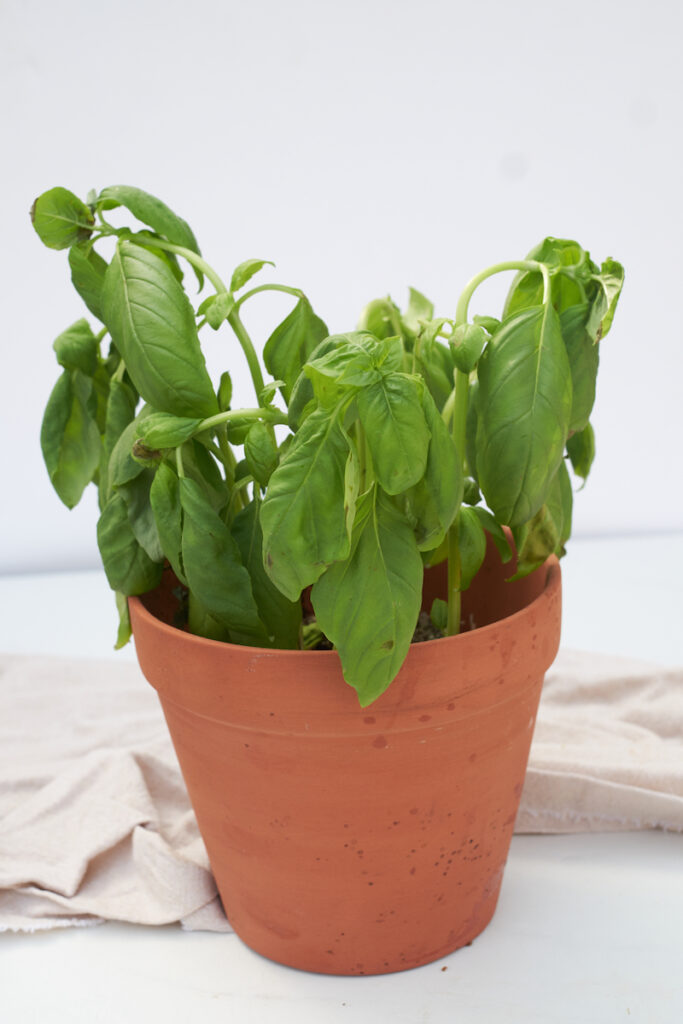
With a little practice and the tips below, you’ll worry less about watering your basil, and get back to enjoying the flavor of fresh sweet basil leaves and other herbs with every meal!
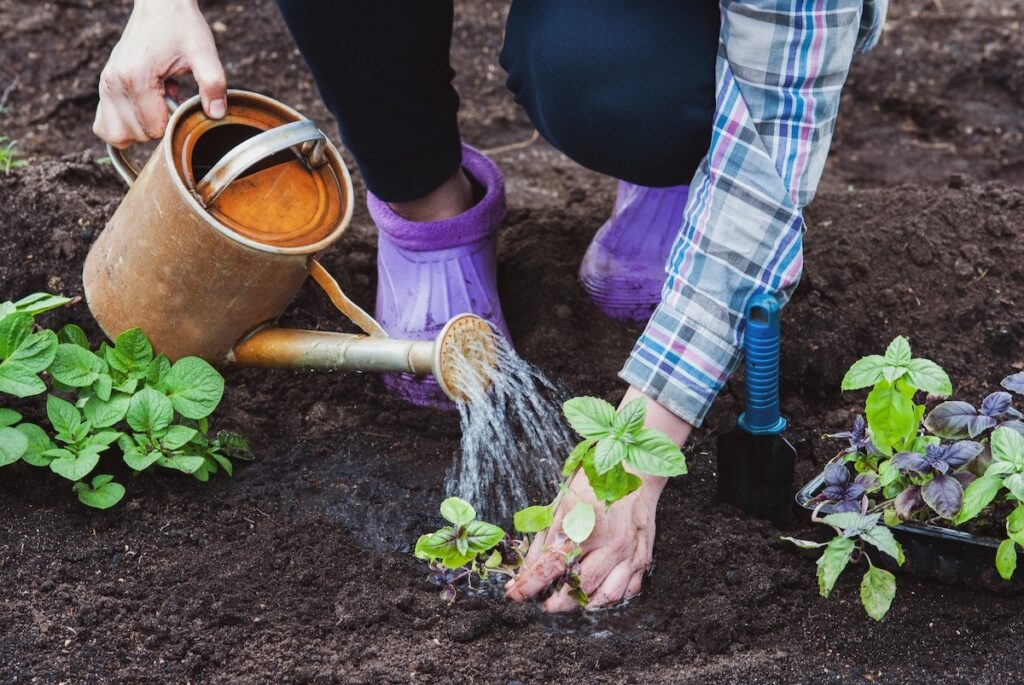
More Than 7,000 People Can’t Be Wrong!
For one-off problems with your basil or herb garden, a quick Google to solve the problem is great.
But if you want more help getting the herb garden of your dreams, mastering cooking with basil, or other creative uses of basil, Skillshare has some awesome herb-related courses (plus a ton of other interesting, useful and cool courses).
To date, more than 7,000 students have taken Indoor Gardening: Grow Houseplants, Veggies, and Herbs!
Normally Skillshare Gives A 7-Day Free Trial. You Get A 30-Day Free Trial (OR 30% Off An Annual Membership)
Our friends at Skillshare have graciously offered our readers an extended free trial, using this link here to sign up. Instead of 1 week to try out all their courses, you get a full month to try courses like:
- Indoor Gardening: Grow Houseplants, Veggies, and Herbs // (use this link to get a 30-day Free trial) // (use this link to 30% off an Annual Membership)
- Create a Small Space Edible Garden // (use this link to get a 30-day Free trial) // (use this link to 30% off an Annual Membership)
- 5 Easy to grow herbs, sowing, growing and harvesting // (use this link to get a 30-day Free trial) // (use this link to 30% off an Annual Membership)
- Crafting Infused Tea: Herb, Flower, and Fruit Iced Teas // (use this link to get a 30-day Free trial) // (use this link to 30% off an Annual Membership)
Sign up for a FREE 30-Day Trial (this link only)
Or Save 30% Off An Annual Skillshare Membership
If you know you’re going to love Skillshare, you can also sign up for an annual membership and save 30% with this link.
The Bottom Line: How Often to Water Basil
Generally speaking, basil plants need to be watered between every 2 days to once per week, depending on how and where it’s planted; the container you use; the type of soil you have; how much direct light and heat it gets; climate, weather and temperature conditions; what season you’re growing in; and whether you’re growing your plants indoors or outside.
However, it’s fair to say that watering basil is a bit tricky.
Plenty of beginner herb gardeners have observed too much water (which can lead to a rather yellow-looking basil plant!) or too little water will ruin, stress, or kill their basil plants.
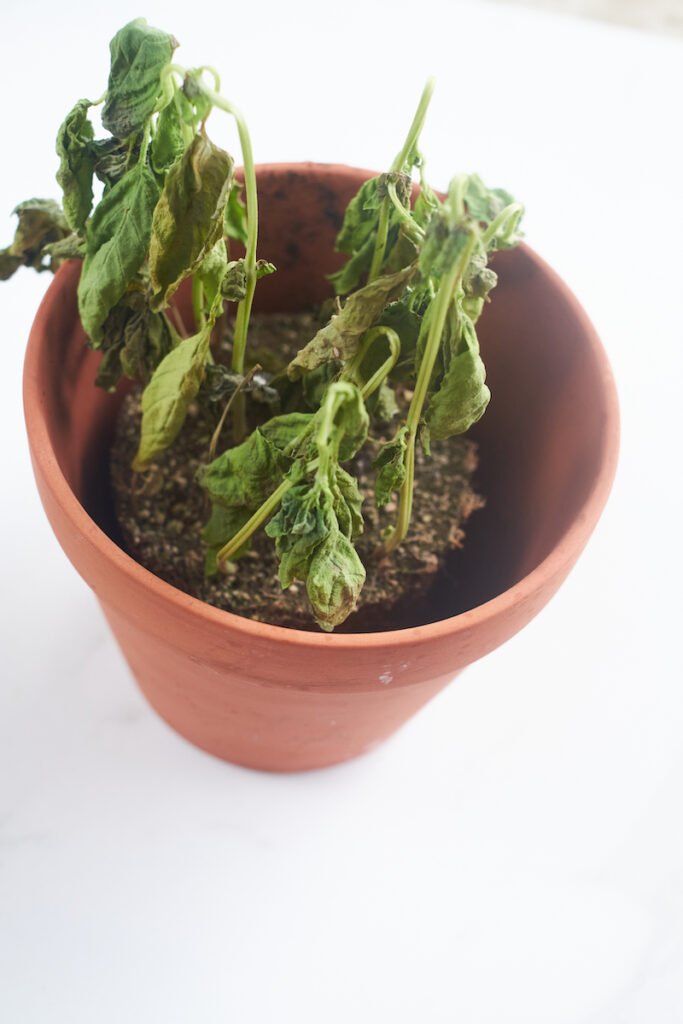
Indeed, basil plants need consistently moist soil, but overwatering basil plants so the soil is soupy or boggy can lead to root rot, wilting or drooping basil, and a distressed plant (which can attract pests, which will eat your plant!).
Likewise, you need to water the soil and base of the stem, rather than the leaves, as wet leaves can cultivate bacterial and fungal infections that lead to black spots, white spots, or brown spots on leaves.
In the photo below, you can see some white fuzz developing on the soil of my cardinal basil seedling, which is grown hydroponically. I accidentally spilled some water on the soil when trying to fill the reservoir, and their wasn’t enough airflow at the base of the plant to prevent this from growing.
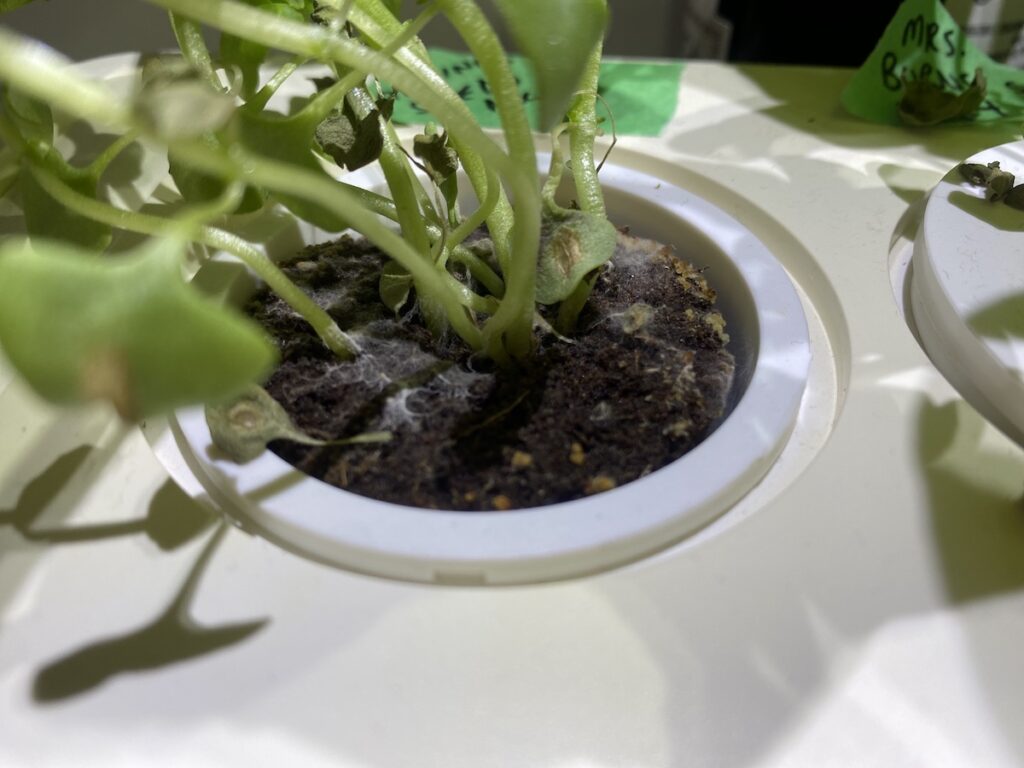
A good rule of thumb is to water every 3 to 4 days to once per week. However, the specific conditions of your plant also matter.
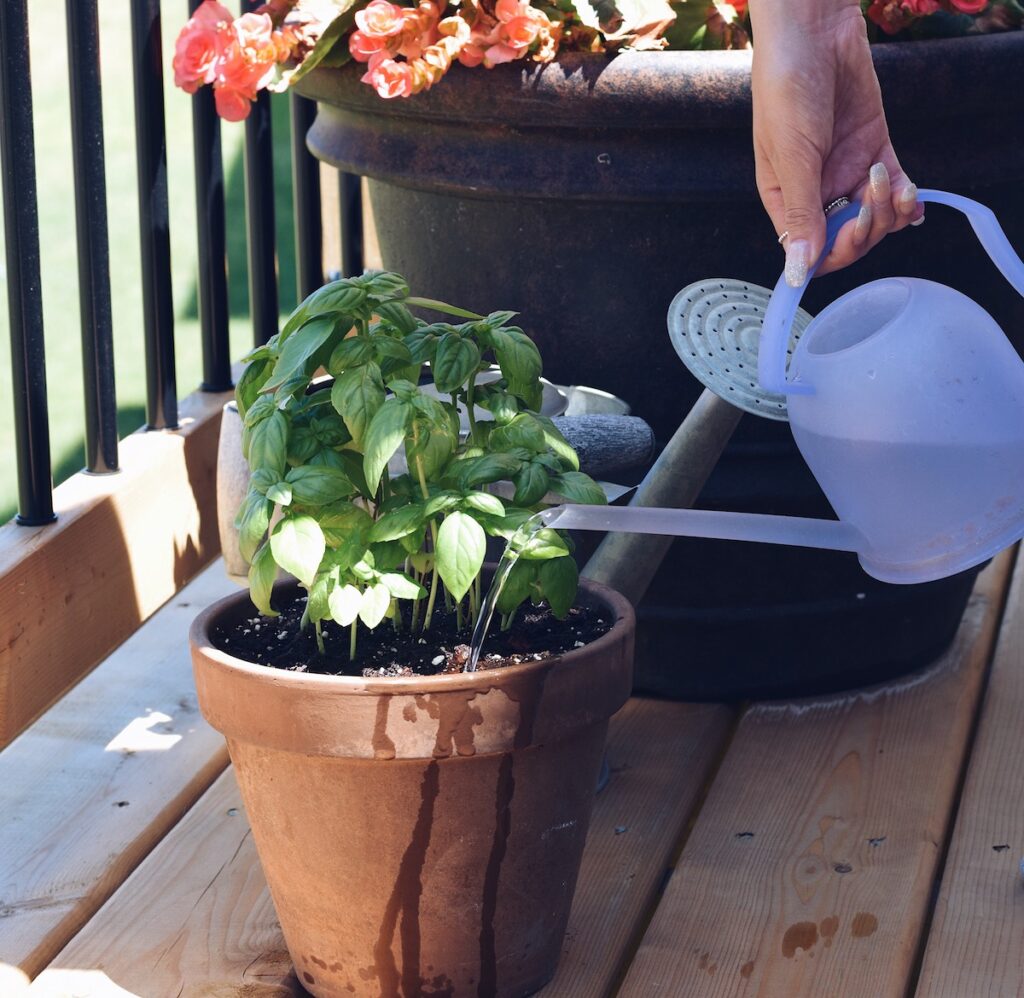
How Much Water Does Basil Need? It Depends…
Is your basil planted outdoors in nutrient dense and well draining soil or in a tiny plastic container from the supermarket? Do you live in sunlight drenched Florida or rain drenched Seattle? Do you have an indoor herb garden or ample space outdoors?
All of these factors make a huge difference in terms of how often you should water your basil plant. Keep reading for my tips to figure out the optimal schedule.
How Often to Water Basil in Plant Pots or Containers (Growing Outdoors)?
Water basil planted in plant pots or containers every 2 to 4 days, unless it’s unseasonably hot. Soak them until water trickles out the bottom of your planter, giving plenty of room for the excess water to drain away (not pool near the base of the planter).
Plant basil in large planters, measuring at least 12 inches across and made from natural ceramic or terracotta. Pots are well draining, and you’re able to control soil conditions by only planting with nutrient dense soil mixed with compost. Good soil means better moisture retention, which means less frequent watering and healthier, more aromatic basil and healthier roots. Growing your basil in a pot also makes it easier to keep pests away from your plant.
When optimizing for watering your potted basil plants:
- Monitor soil moisture consistently to ensure the soil doesn’t dry out. On hotter days, in particular, check the soil daily by sticking your finger into the soil, all the way up to your knuckle. If the soil feels even somewhat dry, then it’s time to water the plant until the water flows out of the bottom drainage holes.
- A larger pot is better for moisture retention than a smaller pot. A small container has less soil, which therefore dries out faster, especially when sitting in full sun, which basil thrives in. Ideally, you’ll pot your basil in a planter that’s at least 12 inches across.
- Pots made from natural materials, such as terracotta or clay, are better for retaining moisture than plastic or metal containers. This is because they don’t conduct heat as efficiently as plastic and metal, and staying cooler helps the soil retain moisture longer.
- If you’ve recently transplanted basil plants to a new pot, or transferred a plant that had been propagated in water to a pot, pay extra careful attention to ensure you keep the soil moist enough.
How Often to Water Basil Planted in Your Garden?
For planted garden basil, water every week / once weekly. In higher temperatures or during a rainless stretch, increase this to every 3 to 4 days.
Basil that’s established in your garden will generally need slightly less water than basil in a plant pot. However, you still need to factor in your climate, the season and conditions (wind, rain, humidity, sunlight, temperatures), soil quality, and how healthy your plant is.
Ideally, your basil has been planted in rich, high quality soil, with good drainage, that’s augmented with compost. Higher quality soil means better moisture retention, and hardier, more established plant roots, which means you need to water it less.
To maximize the health of your basil plant before planting, take the time to prepare the soil with plenty of organic matter, such as compost or leafmold.
To improve moisture retention even further once you’ve planted your basil, you can also add mulch to the surface of the soil, which will reduce evaporation and let the roots retain moisture.
As your basil grows, harvest the leaves regularly – both healthy leaves to encourage more growth, and to be getting rid of dead foliage.
Basil planted in these conditions (high quality soil, good drainage, covered in mulch) can be watered once per week in cooler climates, and twice weekly in hotter climates. When you water, give the plant a good soak to ensure the moisture gets right down to the plant roots.
If you don’t have ideal soil conditions, you’ll need to pay closer attention to your plants’ needs and moisture levels.
Slow draining soil, such as clay, and faster draining soil, such as sandier types, will need less and more water, respectively.
If you find you can’t maintain ideal moisture levels in poorer quality soil, consider re-planting your basil in a pot.
How Often to Water Indoor Basil?
Water basil that lives indoors every 3 to 5 days, making adjustments depending on your use of heat/air conditioning and the humidity inside your house, pot size, and placement of the plant.
Indoors, basil leaves require full sun and the roots need good drainage holes. Place the plant somewhere where it can soak up the sun’s rays to maximize for growth, and plan for excess water to drip away after watering.
Typically, I like to keep containers near the window, and move it to the kitchen for watering. Let most excess water drain away through drainage holes so as to not to risk overwatering or damaging the roots. Then move it back to the window and place the pot on folded kitchen tea towel or a few layers of paper towel.
With a change of season or when you change conditions indoors (humidity, turning on central heat to increase temperature in the winter, etc), pay a bit more attention to your indoor plant to see how you need to adjust your watering schedule. Go back to checking soil moisture with your fingers daily and generally making sure it stays healthy (which also maximizes for flavor!). If the plant is drying out more frequently, increase your watering.
Basil plants thrive in larger planters, as the roots develop better and the larger volume of soil can maintain moisture more easily. If your basil is planted in a large pot (12″ across or more), you can water the plant less than if it’s in a small container, such as what you get from the supermarket.
If you want to maximize for cooking and using your basil, you’ll also get more leaves when your basil is in a larger pot! Just make sure you prune it regularly and don’t let it go to flower. If it does flower, be sure to collect the seeds so you can re-plant them next growing season!
How Much Water Does Basil Need in Different Weather Conditions?
Your basil plant’s watering needs will change with the seasons. As the seasons change, you get unseasonably hot or cold days in your area, or your climate changes indoors in your home, pay attention to your plants and their changing moisture levels so you avoid overwatering or under watering, and keep the plant nice and healthy.
How Often Should You Water a Basil Plant in Hot Weather
During particularly hot stretches, watering basil needs to increase so the plant has enough moisture.
For basil in pots for use on a porch or deck, water daily during the summer. You can stretch it to every 2 days on cooler summer days, depending on the heat. In extreme heat waves – such as the heat dome experienced in the PNW this year – it may need a bit more. Consider a same day top up to keep the root system moist and reduce wilting.
Basil in the garden will need a little less watering. On hot days, up your watering to every 2 or 3 days when it’s hot or particularly dry.
Water in the early hours, before the heat of the day sets in, or after dusk. While always a good policy to water in the morning hours, it’s especially important when it’s really hot out, as it gives the plant the water it needs to withstand a higher temperature than its used to.
How Often Should You Water a Basil Plant in Cool Weather
In cooler weather, or when you’ve got some rainfall, you can reduce your watering schedule for basil plants to around once a week, to avoid overwatering.
Check the soil for moisture to a fingers depth if you are unsure whether to water. If it feels only slightly moist, ensure you give the basil a good soak, without making it boggy.
What About Growing Basil from Seed? How Often Do You Need to Water Basil Seedlings
If you’re germinating basil from seed, water the seedlings every second day, while checking the soil to ensure it drains properly and is retaining the moisture well.
Growing a basil plant by sowing it from seed requires a different watering schedule than established basil plants, as the seeds haven’t developed mature and healthy root systems yet. This means the soil needs to be more consistently moist, and you need to ensure the top couple of inches of soil maintains moisture.
Despite the difference in frequency of waterings, basil seedlings more or less require the same soil conditions as established plants: moist soil that isn’t soggy or boggy. Water in the morning, before the day gets too warm, as seedlings are particularly vulnerable and may not be able to withstand hot weather without moist soil.
How Often Should You Water Basil: Quick Summary of Tips
- With a basil plant, the goal is to keep the soil consistently moist, but not too wet or dry.
- To achieve optimal soil moisture and growth, you generally need to water basil every 3 to 4 days. When it’s really warm out, every day to every second day is suitable. When it’s cooler out, you may be able to water your basil as little as once a week. Indoor basil generally requires watering every 3 to 4 days.
- When first starting out growing basil, or when you try growing basil in different conditions than you’re used to (a new place in your garden, a different sized pot, etc), monitor soil moisture daily. Simply stick your finger down in the soil all the way to your knuckle. If it’s slightly dry, it’s time to water.
- Basil plants in a plant pot generally need more frequent watering than basil that’s in the ground in your garden. Likewise, potted basil in larger planters and pots made with natural materials (ceramic, terracotta, etc) require less water than those in smaller planters made with plastic, as more soil volume and natural materials equals better moisture retention and heat dissipation.
- Growing basil from seed requires more frequent watering than growing established plants. If you have seedlings, you’ll most likely have to water daily until the roots develop.
- Basil requires excellent drainage, so ensure your pots have holes in the bottom, and are position so that excess water can drain away when it leaks out the bottom of the pot.
- If you’re having trouble keeping your basil soil moist, you can try adding mulch to the top of it, which will help keep moisture from evaporating.
Frequently Asked Questions
Can basil be overwatered?
Yes, you can overwater basil. Basil thrives when it is consistently moist, but not drenched. For this reason, it’s important to plant basil in well-draining soil (or pots with drainage holes). However, even with drainage holes, overwatering basil will cause a loss of nutrients in the soil, and may also lead to root rot.
How do I know if my basil is overwatered?
A tell tale sign of overwatered basil is leaves that are turning yellow or brown. If overwatering isn’t corrected and continues, the plant may start to droop, and the roots may start to rot, causing the plant to give off a noticeable stench.
How do you fix an overwatered basil plant?
If you overwatered your basil plant once, simply let the soil dry out before you water again. To avoid the problem again, check that the drainage is adequate, and reduce your watering schedule so the soil is consistently moist, but not drenched, when you stick your finger about an 1″ deep from the surface. You can also remove damaged leaves and prune the plant to encourage growth, and remove any mulch you added to the soil surface to keep the moisture in.
What does basil look like when it needs water?
Check the soil by sticking your finger 1″ to 2″ below the surface to feel for moisture. If it’s dry, the basil plant needs water. Soil that looks cracked or is gaping away from the sides of the pot is also too dry. The plant itself will look a bit lifeless – yellowing leaves or leaves that aren’t as vibrantly green as they should be (i.e. dull, pale), with drooping or wilting, pointing down.
